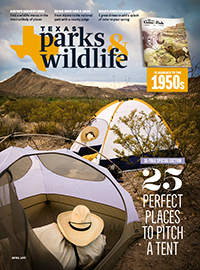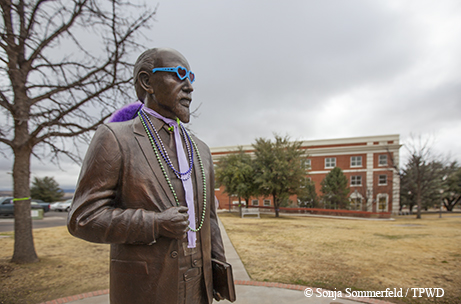
Wide Open Spaces
Destination: Big Bend Country
Travel time from:
Austin – 6 hours
Dallas – 7.5 hours
El Paso – 3.5 hours
Brownsville – 9.5 hours
San Antonio – 5.5 hours
Lubbock – 4.5 hours
Brewster County judge takes the backroads on two wheels to find peace and quiet.
By Melissa Gaskill
Photos by Sonja Sommerfeld
The largest county in Texas, Brewster County covers 6,169 square miles yet has only about 10,000 residents. This makes it perfect for people looking to get away from it all.
Sometimes, Brewster County Judge Eleazar Cano is one of them.
“In my work, I’m around people all the time, constantly engaged,” he explains. “So I’m drawn to the remote places. I like the quiet, being away from civilization.”
One way he does so is riding his Yamaha 1600 motorcycle. One night, he followed Texas Highway 118, a two-lane road that bends around hills and dips across broad valleys for 80 miles between Alpine and Study Butte, through countryside little touched by human hands. He felt the ground shake and turned to see a herd of horses thundering through the dark.
“I got a spiritual feeling, like being part of something bigger than yourself,” he recalls.

Brewster County Judge Eleazar Cano at the Alpine courthouse
I don’t have a motorcycle, but the judge assures me the county offers many ways to get that same feeling. He suggests an evening on the porch at the Starlight Theatre restaurant in Terlingua. Early in the 20th century, this area produced much of the nation’s mercury or quicksilver. A movie house the mining company built for its workers became the restaurant, and the adjoining company store now houses the Terlingua Trading Company. The establishments share a large porch with a sweeping view of the mountains of Big Bend and Mexico. Locals and tourists hang out to socialize as light fades from the sky. Someone usually plays guitar, and music spills out the door of the Starlight — tonight’s band is A Few Too Many from Alpine — while the local dog population mingles with the crowd.
“The porch is one of my favorite places in the world,” Cano says. “It’s a very Zen thing, a peace and tranquility I can’t describe.”
Cano grew up in Alpine, his mother from Presidio and his father from Chihuahua, Mexico. After graduating from high school in 1984, he attended local Sul Ross State University for two years before heading east to Austin. There, he earned a degree in criminal justice at St. Edward’s University, got married and had three daughters. He tried law school but found his passion in mental health counseling. He and his wife, Tonya, came back to Alpine so he could earn a master’s degree at Sul Ross.
When they drove over the hill into town, Cano remembers thinking how beautiful it was. “I looked at it as coming back home,” he says.

Holland Avenue in Alpine.
Tonya passed away in 2010. Feeling it was time for a change, Cano ran for county judge, taking office in January 2015. By that time, he had remarried, and he and his wife, Shay, had a son, Koa. Cano looks forward to showing his youngest around their sprawling county.
He’ll probably start with Brewster County’s most famous attraction, Big Bend National Park, and his favorite part of it, the Chisos Basin, a bowl surrounded by mountain peaks ranging from 5,600 to 7,800 feet. Rainfall in the Basin drains through the Window, a notch between Ward and Vernon Bailey peaks. The Window Trail, a 5.6-mile round-trip, descends through scattered juniper and pine into a narrow, wooded canyon that becomes rocky before ending at the pour-off, 4,600 feet above the desert below.
Cano took his daughters, Alyssa, Katrina and Elena, to hike this trail when they were young. All three, now young women, have returned on their own. We make the hike on a partly sunny winter’s day, with Mexican jays and titmice flitting through the bushes and the distinctive song of canyon wrens echoing off the walls. Oak Creek trickles through the rocks near the pour-off, where people line up to take pictures of the stunning westward view through the notch.

The moon peeks out behind a butte in Big Bend National Park off Ross Maxwell Scenic Drive.
One hike barely scratches the surface of this 800,000-acre national park, of course. So, I spend the better part of a day on the Ross Maxwell Scenic Drive, taking in Sam Nail Ranch, Mule Ears Viewpoint and the iconic Santa Elena Canyon Trail. This short route provides a taste of the 7-mile gash the Rio Grande cut through 1,500-foot high Mesa de Anguila. Sheer cliffs rise on either side of the narrow river, which divides the national park from Mexico.
I also wander Cottonwood Campground, where the tall trees attract a wealth of birds. In a matter of minutes, I see a vermillion flycatcher, yellow-rumped warbler, golden-fronted woodpecker and a great-horned owl.
At least a half-dozen other hikes beckon along the road, but with time for only one more, I choose Balanced Rock. Its trailhead lies almost 8 miles down unpaved Grapevine Hills Road, which starts just west of the turnoff to the Basin. The Grapevine Hills Trail follows a sandy wash for three-quarters of a mile through a canyon of granite rocks eroded into fantastic shapes. The final quarter-mile is a scramble up to an enormous rock perched atop one column and leaning against another. It frames a view of miles and miles of wildness and distant mountains, awash in quiet and solitude.
Back in Alpine, Cano recommends a stop at the Museum of the Big Bend on the Sul Ross campus.

A statue of Sul Ross, former Civil War general and Texas governor, gets a makeover at Sul Ross State University.
“It’s a real gem. Folks come from all over the place to see the things they have on display,” he says. Housed in an imposing rock building dating to 1936, the museum packs a lot in a small area. Its permanent Big Bend Legacy exhibit covers the area’s natural and human history, beginning with the Texas pterosaur, or Quetzalcoatlus northropi, a fossil discovered in the national park in 1971. Pterosaurs lived in the Late Cretaceous, some 68 million years ago, and this individual’s wingspan stretched more than 36 feet, making it the largest-known flying creature ever.
The museum’s timeline continues with a re-created rock shelter painting and moves on to the Jumano Indians, European explorers, the Mexican War of Independence, the Texas Revolution, the formation of the national park, cowboy life, mining, the candelilla harvest, the establishment of Sul Ross and more. There’s even a replica of the Window for those not fortunate enough to hike to the real thing.
To balance all that solitude with some socializing, we pop into the Saddle Club on Alpine’s main drag, Holland Avenue. Colorful tables and an eclectic collection of chairs line a wall opposite a long bar (where one of the seats is an actual saddle), with a shaded patio in the back. “Good appetizers, good atmosphere, good music,” Cano describes it. We missed Taco Tuesday, but thanks to a daily tapas menu, burger of the week and Epic Fries (beer-battered fries topped with queso, BBQ brisket, bacon, roasted red pepper aioli and green chili sauce), no one goes hungry.
Cano also frequents Reata Restaurant, on the corner of West Avenue and Fifth Street a short walk from his courthouse office. Its self-described “sophisticated cowboy cooking cuisine” includes originals such as tenderloin tamales along with classics — enchiladas, chile rellenos, chicken-fried steak. The judge’s favorite dish is the rib-eye, medium rare, eaten on the patio when weather permits (which it usually does). Named for the ranch in the movie Giant, filmed in this area in the 1950s, the Reata was the brainchild of local rancher Al Micallef and Fort Worth businessman Mike Evans.

Starlight Theatre restaurant in Terlingua.
For special occasions, the Cano family heads down the road to Marathon and the 12 Gage Restaurant at the Gage Hotel. Rancher Alfred Gage built this Mission-style structure, designed by El Paso architect Henry Trost, in 1927, and Houston oilman J.P. Bryan restored it in the late 1970s. The 12 Gage menu emphasizes seasonal and locally sourced wild game, beef and fowl complemented by fresh vegetables and herbs. Here, too, Cano gravitates to the outdoor patio, which features fireplaces and fountains.
“You notice a lot of places in the county have outdoor sitting areas,” he points out. “Because of our weather, you can be out of doors for nine or 10 solid months.”
Just east of the Gage lies another of the judge’s favorite motorcycle rides, the 5-mile Post Road from U.S. Highway 90 to Post Park. Officials at Fort Davis established Camp Peña Colorado here in 1879 to protect freighters and wagon trains plying the Chihuahua Trail. Today, tall cottonwoods line a spring-fed pool created by the Works Progress Administration in the 1930s.
“The stargazing there is incredible,” says Cano.
That can be said of most of the county, which boasts some of the darkest skies in the country. Marathon offers stargazing programs at the Marathon Motel using a 24-inch Dobsonian telescope. Big Bend National Park received official designation as an International Dark Sky Park and offers plenty of spots to lie back and look up at the Milky Way. The galaxy is even visible just a short walk from the Starlight porch in Terlingua.
“Brewster County is just so beautiful, the openness, being off the beaten path,” Cano sums up. “I love how everybody knows everybody.” It seems a perfect combination: plenty of wide open space to roam and friendly folks waiting back on the porch.
More Info:Alpine visitor information Starlight Theatre Big Bend National Park Museum of the Big Bend Saddle Club Reata Restaurant Gage Hotel
|
» Like this story? If you enjoy reading articles like this, subscribe to Texas Parks & Wildlife magazine.
Related stories
See more travel stories on TP&W magazine's Travel page

